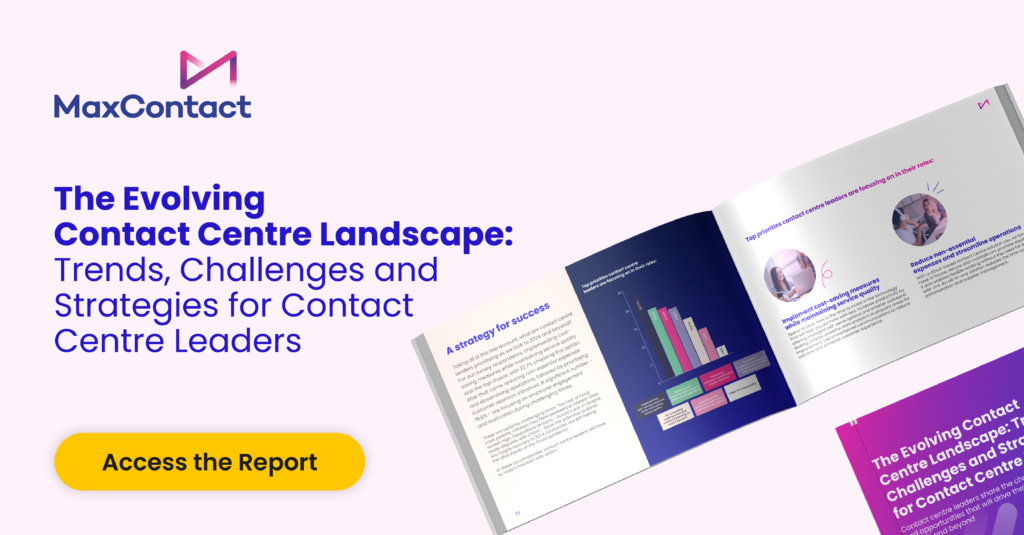This has been a year of challenge and change for the contact centre industry. On one hand, the hype around ChatGPT brought AI into the mainstream, even if AI-powered chatbots and speech analytics have been part of advanced contact centre solutions for a number of years. With growing customer and agent acceptance, the continuing development of these technologies will bring new opportunities for efficiency and service enhancement to the sector.
On the other, 2023 was in many respects a difficult year, thanks to a tough macroeconomic climate, new regulatory requirements and growing customer expectations. These factors piled more pressure onto already stretched contact centre teams.
It all added up to a need for agility and adaptation in the face of evolving demands. MaxContact was happy to be able to help our clients meet that need; we were recently named one of the top CCaaS vendors of the year. We’ll carry on the good work in 2024.
But more widely, what will the new year bring? Let’s gaze into the MaxContact crystal ball…
AI will evolve and spread
Investment bank Goldman Sachs predicts that 2024 will be the year generative AI moves from the “excitement phase” to the “deployment phase”.
In other words, expect to see the continued development of AI in 2024 across sectors and industries. Contact centres will be no exception. For example, AI-driven chatbots are likely to improve further, handling more complex queries and providing more human-like responses through breakthroughs in natural language processing (NPL).
AI tools will spread to more areas of contact centre operations. AI-powered workforce management algorithms will help companies maximise agent time while reducing costs. Predictive analytics will be used to accurately gauge contact volume and improve customer experience.
But it may also be the year when contact centres strike a better balance between human and AI-driven customer interactions. The human touch will always be needed. AI will be deployed in ways that give human specialists the time they need to focus on more complex, sensitive or emotionally intense calls and conversations. The development of AI will drive progress in the refinement of the agent role.
Finally, AI will be deployed to analyse conversations and provide feedback for training and quality assurance purposes. Speech and conversational analytics will measure the quality of customer interactions and highlight areas of potential improvement.
Security and compliance will be front and centre
Contact centres often handle sensitive data and face strict rules around the quantity and quality of customer interactions. Security and compliance are a continual challenge.
But a couple of specific developments mean they will become even more of a priority in 2024. The first part of the new Consumer Duty legislation came into force in 2023, with the second part scheduled for July 2024.
Consumer Duty rules require companies in the financial services sector to communicate with consumers in a way that promotes fair treatment, positive customer outcomes and increased transparency. As the most customer-facing department of all, contact centres in the sector have a duty to fully understand and apply the new legislation.
On the upside, emerging AI will play an increasingly key role in the compliance space, helping contact centres identify vulnerable customers and those who may be more likely to fall into payment arrears.
And AI itself may become subject to regulation. There are already concerns about AI’s use of corporate and individual data, and some experts predict the introduction of an “opt-in” model, where customers are asked for their permission before personal information can be used for AI analytics.

Contact centres will refine hybrid working models
The trend towards flexible and remote working that was accelerated by the pandemic is not going away. A recent poll by the Call Centre Management Association (CCMA) found that the vast majority of contact centre leaders (98%) expected hybrid, flexible and remote working patterns to be standard practice in 2024 and beyond.
The industry will continue to adapt to this reality over the next 12 months, optimising hybrid arrangements to ensure a seamless blend of remote and in-office operations. Careful workforce management will be required, alongside cloud-based “work anywhere” technology solutions. Agents working in a hybrid model need digital tools that are there when they need them, whether that’s in the office or at home.
Training and coaching are also elements that can’t be overlooked. Out of sight must not mean out of mind when it comes to continual improvement. Agents that work remotely need the same access to training and feedback loops as in-office counterparts. Analytics can provide detailed information on agent performance, so that tweaks to the model can be made if any drop-off occurs.
Of course, there are other challenges with implementing hybrid working models, including the need to establish strong security policies and promote collaboration among dispersed teams. But the benefits – employee satisfaction, cost savings and access to a wider talent pool – are compelling.
Overall, we think 2024 will be the year when contact centres further embrace and refine hybrid working models, for the benefit of both agents and customers.
A new focus on sustainability and corporate social responsibility (CSR)
Environmental, Social and Governance (ESG) initiatives are now common in businesses of all kinds, as organisations transition to more sustainable and inclusive practices. Contact centres are not immune from these trends; in fact, implementing green practices in contact centres can go a long way to helping companies meet overall sustainability targets.
There are very good reasons why they should. A growing body of evidence shows that both consumers and employees want to be associated with sustainable organisations. Going green isn’t just good for the planet, it’s also good for business.
So what can contact centres do? The most impactful move is likely to be the introduction of remote or hybrid working, as discussed above. Implementing hybrid working models cuts commuting, and with it carbon footprint. One recent study found that “remote workers could have a 54% lower carbon footprint compared to onsite workers.”
Choosing energy efficient technology, implementing paper-free policies and introducing recycling programmes can also help. Energy-saving lighting and heating regimes can have a significant impact on office greenhouse gas emissions.
But ESG and CSR are about more than the environment. Staff and customers (not to mention regulators) increasingly demand inclusive recruitment strategies that don’t discriminate on the grounds of race, gender, religion or sexual orientation. In addition, charity events and volunteering days show a human side to organisations and tend to be well received.
We can say with certainty that ESG and CSR trends are only heading in one direction. In 2024, pressure is only likely to grow on contact centres to prove that sustainability, responsibility and inclusivity are at the core of their vision.
Reducing costs while improving performance and customer experience
In 2024, contact centre leaders will be expected to improve performance while taking an even tighter grip on costs. This is inevitable if – as seems likely – inflation and interest rates remain high and the economy makes only a stuttering recovery from the doldrums of the post-pandemic downturn.
This isn’t just our opinion. In our own recent research – you can find it here – more contact centre respondents chose “implementing cost-saving measures while maintaining service quality” than any other priority for 2024.
How can this squaring of the circle be achieved? Certainly, implementing better technology is a large part of the answer. The latest digital tools can help contact centre leaders streamline processes and more efficiently manage resources, while also giving agents the time and information they need to create better customer interactions.
Agent expertise is crucial here. Well-trained, confident agents resolve issues more quickly, make and take more calls and provide a more complete customer service, reducing costs while elevating performance. When they’re backed by intuitive IVR systems, integrated CRM solutions and automatic payments, the cost and productivity benefits quickly mount up.
Conclusion: Charting a course for 2024
The next 12 months will certainly be challenging for the contact centres, as the last 12 months have been. In a difficult macroeconomic environment, they will be expected to improve customer experiences, meet sustainability goals, refine working practices and implement game-changing technology, and all while keeping costs firmly under control.
But none of this is impossible. The industry proved during the pandemic that it is adaptable, resilient and creative. In the next 12 months, agility, flexibility and an openness to innovation will be the core attributes of thriving contact centre businesses.
We are entering a new era. Customer and employee expectations have never been higher. At the same time, the effective use of AI and analytics has the potential to revolutionise operations. Against that backdrop, leaders who fail to move with the times risk being left behind, while those who innovate and adapt will be the ones who forge ahead.
Why MaxContact?
In 2024 MaxContact can help you transform your customer and employee experience while creating a more effective and efficient contact centre. MaxContact’s contact centre software offers an unrivalled omnichannel contact experience, as well as easy access to the latest AI tools. And because it’s completely cloud-based, equipping a remote or hybrid workforce with the secure solutions they need has never been easier. Contact us to find out more.





